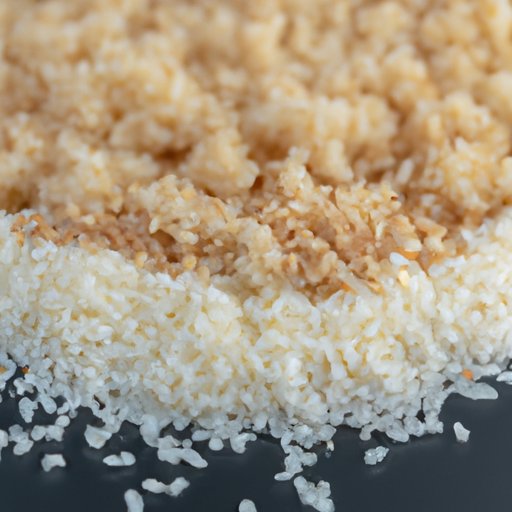Introduction
When it comes to making sushi, the rice is perhaps the most important component. If the rice is not cooked properly or seasoned correctly, the whole dish can be ruined. That’s why it’s crucial to get it right. The purpose of this article is to provide a step-by-step guide, video tutorial, and additional information to help readers make perfect sushi rice.
Step-by-Step Guide
Before cooking sushi rice, it’s important to rinse it thoroughly to remove excess starch and dirt. This helps to ensure the rice cooks evenly and has the desired texture.
To cook sushi rice, use a rice cooker or a heavy-bottomed pot. Add one cup of sushi rice and 1.25 cups of water to the pot. Let the rice soak in the water for at least 30 minutes before cooking.
Once the rice has soaked, place the pot over high heat and bring the water to a boil. As soon as the water starts boiling, give the rice a stir, reduce the heat to low, and cover the pot with a lid.
Let the rice cook for about 15-18 minutes, or until all the water has been absorbed and the rice is tender. Remove the pot from the heat and let it rest for 10 minutes.
Next, use a wooden spoon to gently mix the rice, being careful not to crush the grains. Add a mixture of rice vinegar, sugar, and salt to the rice, and mix well. The amount of vinegar mixture you will need will depend on the amount of rice you are cooking, but as a general rule, use about 1/4 cup of vinegar, 1 tablespoon of sugar, and 1/2 teaspoon of salt for every 2 cups of cooked rice.
Once the rice is seasoned, cover it with a damp towel to prevent it from drying out. You can now serve the sushi rice right away or let it cool to room temperature before using it to make sushi rolls.
Video Tutorial
For a visual guide on how to make sushi rice, check out this helpful video tutorial: https://www.youtube.com/watch?v=YZF3tXi4L8Y. The video covers all the key steps, including how to rinse the rice and measure the correct ingredients.
History of Sushi Rice
Sushi rice has been an integral part of Japanese cuisine for centuries. In ancient times, sushi was a way of preserving fish by wrapping it in fermented rice. The rice helped to keep the fish fresh for longer and added a tangy flavor to the dish. Over time, sushi rice evolved into the sticky, seasoned rice we know today.
Traditional sushi rice was prepared by combining cooked rice with vinegar, sugar, and salt. Today, there are many variations of sushi rice, each with its own unique flavor and texture.
One of the key differences between sushi rice and other types of rice is the type of grain used. Sushi rice is usually made from short-grain rice, which has a higher starch content than other types of rice. This helps to give it its unique sticky texture.
Sushi Rice Perfection
To achieve the perfect sushi rice, there are a few tips and tricks you can follow:
- Use a rice cooker or a heavy-bottomed pot to cook the rice evenly.
- Measure the ingredients precisely to ensure the rice is seasoned correctly.
- Adjust the water and vinegar mixture to taste, depending on how tangy you like your rice.
- Let the rice rest for at least 10 minutes after cooking to allow the flavors to meld together.
Sushi Rice Variations
While traditional sushi rice is seasoned with vinegar, sugar, and salt, there are many variations that can add a unique twist to your sushi rolls. Here are a few ideas:
- Add green tea powder to the rice for a subtle, earthy flavor.
- Replace some of the water with sake for a floral, alcoholic note.
- Mix in some furikake (seasoned seaweed) for added umami flavor.
Sushi rice can also be used in other dishes, such as sushi bowls or sushi burritos. Get creative and experiment with different ingredients to find what works best for you.
The Importance of Sushi Rice
When making sushi, it’s important to remember that the rice is just as important as the other fillings. The flavor and texture of the rice can complement or detract from the other ingredients in a sushi roll. That’s why it’s crucial to get it right.
By following the steps outlined above, you can make perfect sushi rice every time. Be sure to experiment with different variations and techniques to find what works best for you.
Conclusion
Making sushi rice may seem intimidating at first, but with a little practice, you can master the art of making perfect rice. Remember to rinse the rice thoroughly, measure the ingredients precisely, and let the rice rest before serving. With these tips in mind, you’ll be well on your way to creating delicious and authentic sushi rolls at home.
